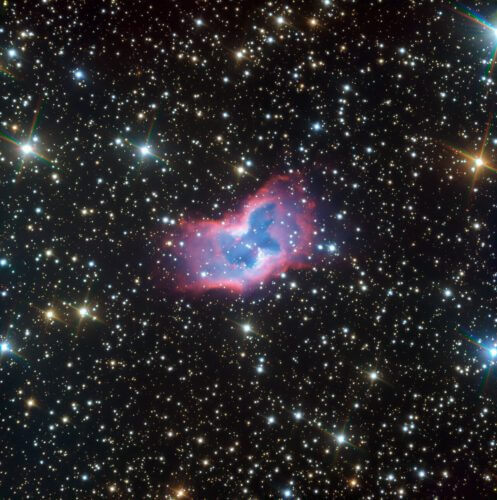Located 3,000 to 6,500 light-years away in the southern constellation Vela (the Sails), the nebula consists of two central stars, which give it its almost symmetrical appearance. After one star has reached the end of its life and shed its outer layers, the other star now interrupts the flow of gas and creates the bilobed shape seen here

This celestial object looks like a butterfly with its symmetrical structure, beautiful colors and intricate patterns. This amazing bubble of gas – a planetary nebula known as NGC 2899 – floats and flutters across the sky in this new image from ESO's Very Large Telescope (ESL) The dryness and the clear sky, as well as the ability to observe the southern sky.
This object has never been photographed in such striking detail, with even the faint outer edges of the planetary nebula glowing against the background stars.
NGC 2899's vast gas shards stretch up to two light-years from its center, glowing brightly against the stars of the Milky Way as the gas reaches temperatures of over ten thousand degrees. The high temperatures are due to the large amount of radiation from the nebula's parent star, which causes the hydrogen gas in the nebula to glow in a reddish halo around the oxygen gas, in blue.
Located 3,000 to 6,500 light-years away in the southern constellation Vela (the Sails), the nebula consists of two central stars, which give it its almost symmetrical appearance. After one star has reached the end of its life and shed its outer layers, the other star now interrupts the flow of gas and creates the bilobed shape seen here. Only about 10-20% of planetary nebulae exhibit this type of bipolar shape.
Astronomers were able to capture this highly detailed image of NGC 2899 using the FORS instrument mounted on UT1 (Anto), one of the four 8.2-metre telescopes that make up ESO's VLT in Chile. This instrument was one of the first to be installed on ESO's VLT and it allowed for a large number of beautiful ESO images and discoveries to be taken. The FORS facility has contributed to observations of light from a gravitational wave source, studied the first known interstellar asteroid, and is used to probe the physics behind the formation of complex planetary nebulae.
This image was created as part of the ESO Cosmic Gems programme, an initiative to produce images of interesting, intriguing or visually appealing objects using ESO telescopes, for the purposes of education and making science accessible to the public. The program makes use of the telescope when it cannot be used for scientific observations. All data collected may also be suitable for scientific purposes, and are available to astronomers through the ESO Science Archive.
More of the topic in Hayadan:

3 תגובות
Friends, that's all Bibi did. Respect for the corrupt.
Interesting statement, I didn't think about that
Could it be true?
What we see now is the situation that was 3000 to 6500 light years ago and now the picture has reached us.
Today the situation is different and we will not know what is really happening.
That's how I understand it and I hope I'm not wrong.